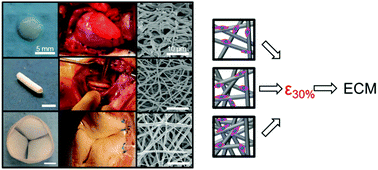Meso-scale topological cues influence extracellular matrix production in a large deformation, elastomeric scaffold model†
Abstract
Physical cues are decisive factors in extracellular matrix (ECM) formation and elaboration. Their transduction across scale lengths is an inherently symbiotic phenomenon that while influencing ECM fate is also mediated by the ECM structure itself. This study investigates the possibility of enhancing ECM elaboration by topological cues that, while not modifying the substrate macro scale mechanics, can affect the meso-scale strain range acting on cells incorporated within the scaffold. Vascular smooth muscle cell micro-integrated, electrospun scaffolds were fabricated with comparable macroscopic biaxial mechanical response, but different meso-scale topology. Seeded scaffolds were conditioned on a stretch bioreactor and exposed to large strain deformations. Samples were processed to evaluate ECM quantity and quality via: biochemical assay, qualitative and quantitative histological assessment and multi-photon analysis. Experimental evaluation was coupled to a numerical model that elucidated the relationship between the scaffold micro-architecture and the strain acting on the cells. Results showed an higher amount of ECM formation for the scaffold type characterized by lowest fiber intersection density. The numerical model simulations associated this result with the differences found for the change in cell nuclear aspect ratio and showed that given comparable macro scale mechanics, a difference in material topology created significant differences in cell–scaffold meso-scale deformations. These findings reaffirmed the role of cell shape in ECM formation and introduced a novel notion for the engineering of cardiac tissue where biomaterial structure can be designed to both mimick the organ level mechanics of a specific tissue of interest and elicit a desirable cellular response.



 Please wait while we load your content...
Please wait while we load your content...